Published: 16 February 2022
Background analysis of candidates and elected councillors in County elections 2022
A total of 1,379 county councillors were elected from among 10,584 candidates in the County elections. The Coalition Party was the largest party in the County elections with 21.6 per cent of all votes cast and the Centre Party received the most seats in the county councils, 297 (21.5%) The Coalition Party gained 289 seats (21.0%) and the Social Democratic Party 277 seats (20.1%).
Share of men and women among the elected by party and age in the County elections 2022, %
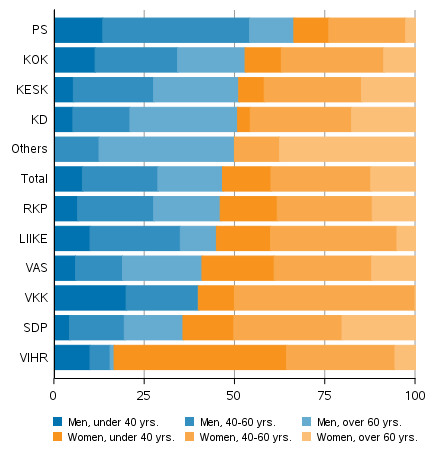
The majority (53.3%) of those elected to county councils were women. The proportion of women was highest among the Green League's elected councillors (83.3%) and lowest among the Finns Party (33.5%). In all, 45.4 per cent of the candidates were women.
The average age of all candidates was 50.3 years, that of male candidates 51.5 and that of female ones 48.7 years. Of all candidates, 2,996 were aged 60 or over. A total of 366 of the candidates were aged 24 or younger. Among the parliamentary parties, the Christian Democrats had the oldest candidates, the proportion of those aged 60 or over was 37.5 per cent and the average age 53. Among the parliamentary parties, the Green League had the youngest candidates, 34.2 per cent of whom were aged under 40 and the average age 45.1 years.
The average age of those elected to country councils was 51.1, for men 53.6 years and for women 49.0 years. The Green League councillors were the youngest, the average age 40.0 years and the Christian Democrat councillors the oldest, the average age 56.5 years. Sixty-six persons aged under 30 (4.8%) and 416 persons aged 60 or over (30.2%) were elected.
Three men and 2.4 women per one thousand men/women entitled to vote had been nominated as candidates. In the Municipal elections, women's candidacy has been lower than men's in all age groups. In the 2022 County elections, up to the age of 50, the proportion of female candidates was higher than that of men in nearly all age groups.
Share of candidates and elected in the age group by sex in the County elections 2022, %
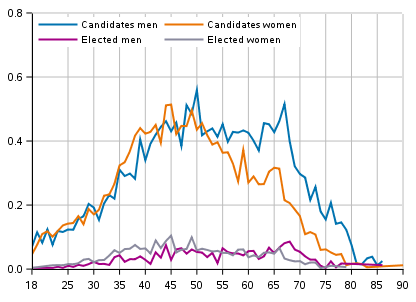
In relative terms, the number of female candidates was highest in Kanta-Häme (50.2%). Clearly fewer female candidates than in the other areas were nominated in Kainuu and Päijät-Häme, under 40 per cent of the candidates.
A female majority was elected to county councils in 13 wellbeing services counties. The share of women among elected councillors was highest in the wellbeing services county of Western Uusimaa (68.4%) and lowest in the wellbeing services counties of South Karelia, South Ostrobothnia and Central Ostrobothnia (44.1%).
Women’s share of candidates and elected by wellbeing services county in the County elections 2022, %
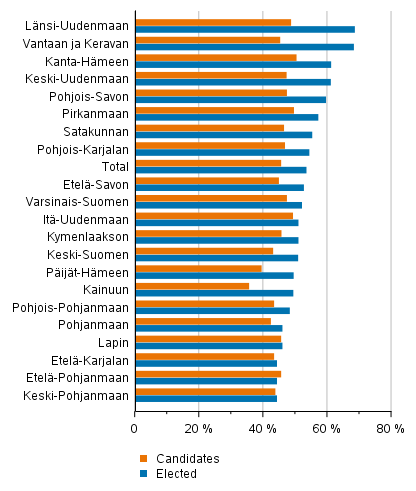
Eighty per cent of all candidates nominated by the parties were also candidates in the 2021 Municipal elections. Of the parliamentary parties, the Finns Party had the highest number of the same candidates, nearly 95 per cent were also candidates in the Municipal elections. The proportion of candidates who also ran in the Municipal elections was lowest for the Movement Now party, slightly over 50 per cent. The majority of the candidates were candidates for the same party in the 2021 Municipal elections as now.
Around 84 per cent of the elected councillors were also candidates in the Municipal elections 2021. In relative terms, the highest number of candidates in the Municipal elections were elected to county councils from the Finns Party (96.8%) and the lowest from the Swedish People's Party (71.1%).
The number of foreign-language speakers, that is, persons not speaking Finnish, Swedish or Sami as their native language, was clearly lower among the candidates than among persons entitled to vote. Slightly over six per cent of the persons entitled to vote were foreign-language speakers, while this is so for 2.2 per cent of the candidates. Among the parliamentary parties, the Green League (4.0%) and the Christian Democrats (3.4%) had the highest number of foreign-language speaking candidates. In the group outside the parliamentary parties, the proportion of foreign-language speakers was bigger than average (3.8%). The proportion of foreign-language speaking candidates was lowest among the Finns Party (1.2%) and the Movement Now party (1.2%).
Fifteen of the elected councillors were foreign-language speakers, which is slightly over one per cent.
Foreign-language speakers’ proportion of persons entitled to vote, candidates and elected councillors(by party) in the County elections 2022, %
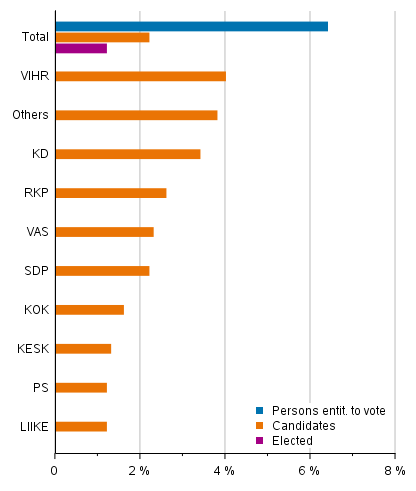
There were citizens of 27 different countries among the candidates. Slightly over four per cent of all persons entitled to vote were foreign citizens. Of the candidates, 66 were foreign citizens. In all, 163 (1.5%) candidates were Finnish citizens with citizenship in another country as well. Among all persons entitled to vote, 2.1 per cent had dual citizenship.
Over 93 per cent of the candidates had completed post-basic level education and slightly over 76 per cent of persons entitled to vote had done so. This is partly explained by the different age structure of people entitled to vote and the candidates. Among the parliamentary parties, the educational level was highest for the Green League candidates, nearly 68 per cent of whom had tertiary level education. Forty-seven per cent of all candidates and 23 per cent of all persons entitled to vote had completed a qualification on that level. The Swedish People's Party and Coalition Party candidates were also more highly educated than average, 63.7 per cent of the Swedish People's Party candidates and 60.0 per cent of the Coalition Party candidates had tertiary level education.
Ninety-seven per cent of the elected councillors had completed post-basic level qualifications. The Green League's elected councillors had the highest level of education. Around 83 per cent of them had tertiary level education.
Persons entitled to vote, candidates (by party) and elected councillors by educational level in the County elections 2022, %
| Basic level |
Upper secondary level |
Lowest level tertiary |
Lower- degree tertiary |
Higher- degree level tertiary, doctorate |
|
| Persons ent. to vote |
23.8 | 44.2 | 9.5 | 12.2 | 10.3 |
| Candidates | 6.6 | 34.7 | 11.7 | 18.7 | 28.3 |
| SDP | 5.8 | 38.5 | 12.9 | 18.6 | 24.2 |
| PS | 11.1 | 51.1 | 10.9 | 14.9 | 12.0 |
| KOK | 4.6 | 22.3 | 13.0 | 18.4 | 41.6 |
| KESK | 4.6 | 28.2 | 16.1 | 18.6 | 32.5 |
| VIHR | 4.8 | 23.1 | 4.6 | 22.7 | 44.8 |
| VAS | 7.5 | 43.5 | 8.4 | 20.5 | 20.0 |
| RKP | 3.9 | 19.0 | 13.4 | 23.5 | 40.2 |
| KD | 6.7 | 31.1 | 13.5 | 18.1 | 30.7 |
| LIIKE | 9.0 | 42.6 | 11.0 | 21.7 | 15.7 |
| Others | 9.8 | 47.1 | 11.1 | 15.8 | 16.2 |
| Elected | 3.0 | 19.4 | 11.7 | 18.9 | 46.9 |
| Male | 1.5 | 14.0 | 12.4 | 22.4 | 49.7 |
| Female | 4.8 | 25.6 | 10.9 | 14.9 | 43.8 |
In all, 70 per cent of the candidates were employed and around seven per cent were unemployed at the end of 2020. Around one-half of persons entitled to vote were employed and 7.6 per cent were unemployed. Clearly fewer of the candidates were pensioners than among persons entitled to vote (around 17%). Around one third of persons entitled to vote were pensioners. The employment rate is calculated as the share of employed persons in working-age population aged 18 to 64.
Persons entitled to vote, candidates (by party) and elected by main type of activity in the County elections 2022, %
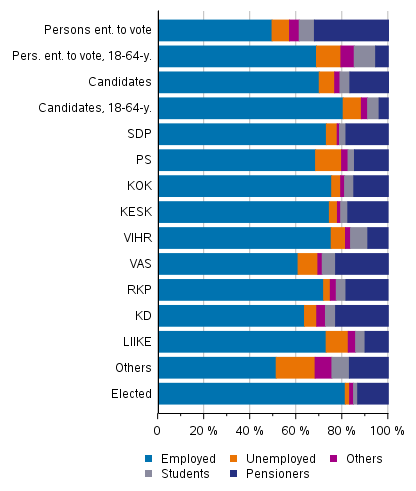
Of all candidates aged 18 to 64, altogether 80.4 per cent are employed. The employment rate for persons entitled to vote aged 18 to 64 is 11.6 percentage points lower. The difference between the employment rates of the candidates and persons entitled to vote is smallest in Ostrobothnia, where the employment rate of the candidates is 6.6 percentage points higher. The difference is biggest in North Savo, where the employment rate of the candidates is 83.4 per cent and that of persons entitled to vote 67.6 per cent.
An even larger share of the elected councillors were in working life than among the candidates. Around 81 per cent of all elected councillors were employed, while the proportion of employed persons among those aged 18 to 64 was around 92.1 per cent. Around 13 per cent of the elected councillors were pensioners.
More candidates were self-employed persons (incl. farmers and forestry entrepreneurs) than persons entitled to vote. The share of self-employed persons was around 14 per cent among employed candidates and slightly over 10 per cent among persons entitled to vote. The highest proportion of self-employed persons was found among the Movement Now candidates (30.2%) and the second highest among the Centre Party candidates (20.2%), of whom around one half were farmers and forestry entrepreneurs.
Of the councillors elected to county councils, 12.3 per cent were self-employed, most from the Movement Now party (36.8%) and the Centre Party (19.8%) elected councillors. Seventy-nine per cent of the elected councillors were upper-level employees, most among elected councillors of the Left Alliance (88.3%) and Christian Democrats (87.5%). Of the elected councillors 3.9 per cent were workers, most in the Finns Party (9.6%).
Persons entitled to vote, candidates (by party) and elected by socio-economic group in the County elections 2022, %
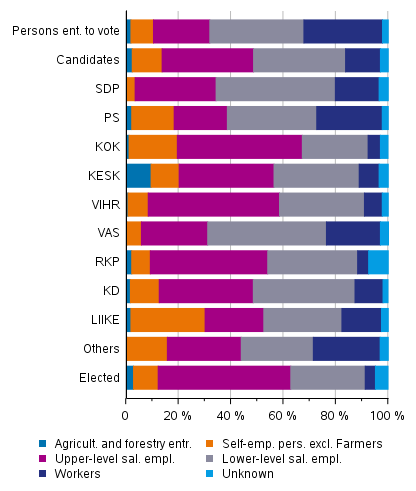
Of industries, most elected councillors were employed by human health and social work activities, 30.1 per cent of the employed elected councillors were working in the industry at the end of 2019. The second biggest industry was public administration, defence and compulsory social security, 24.4 per cent of the elected councillors worked. Of all persons entitled to vote, 17.7 per cent worked in human health and social work activities and 4.8 per cent in public administration. Of the employed elected councillors, 42.3 per cent worked in the local government sector. All in all, 16.0 per cent of the employed elected councillors worked in the central government sector, 29.4 per cent in the private sector and 12.3 per cent as self-employed.
The industry of employed persons entitled to vote, candidates and the elected in County elections 2022
| Persons entit. to vote |
Candidates | Elected | ||||
| number | % | number | % | number | % | |
| A Agriculture, forestry and fishing |
62,358 | 3.1 | 246 | 3.2 | 44 | 3.8 |
| B-E Total industry |
305,328 | 15.0 | 635 | 8.2 | 38 | 3.3 |
| F Construction | 149,694 | 7.4 | 252 | 3.3 | 21 | 1.8 |
| G-H Wholesale and retail trade, transportation and storage |
338,511 | 16.6 | 711 | 9.2 | 51 | 4.4 |
| I Accommodation and food service activities |
73,884 | 3.6 | 169 | 2.2 | 5 | 0.4 |
| J Information and communication |
73,755 | 3.6 | 257 | 3.3 | 23 | 2.0 |
| K, L Financial and insurance activities, real estate activities |
51,149 | 2.5 | 168 | 2.2 | 16 | 1.4 |
| M, N Professional, scientific and technical activities, administrative and support service activities |
261,998 | 12.9 | 763 | 9.9 | 68 | 5.9 |
| O Public administration and defence; compulsory social security |
96,689 | 4.8 | 898 | 11.6 | 283 | 24.4 |
| P Education | 138,540 | 6.8 | 877 | 11.4 | 135 | 11.7 |
| Q Human health and social work activities |
360,425 | 17.7 | 1,877 | 24.3 | 349 | 30.1 |
| R-U Arts, entertainment and recreation; other service activities |
94,210 | 4.6 | 750 | 9.7 | 109 | 9.4 |
| Unknown | 28,913 | 1.4 | 114 | 1.5 | 16 | 1.4 |
The median disposable income of persons entitled to vote was EUR 22,300 in 2020, while that of candidates was EUR 30,900. The candidates' disposable income was, on average, 39 per cent higher than that of persons entitled to vote. Disposable income was highest in the wellbeing services county of West Uusimaa both for persons entitled to vote (EUR 25,900 per year) and for candidates (EUR 34,500 per year). Disposable monetary income refers to the monetary income after taxes that consists of earned income, property income, and transfer income.
In euros, the income differential between the candidates and persons entitled to vote was largest in the wellbeing services counties of South and North Savo, where the median disposable income of the candidates was over EUR 10,000 higher than that of persons entitled to vote. Income differentials were smallest in the wellbeing services counties of Central Ostrobothnia and Central Uusimaa, under EUR 8,000.
The median for the disposable income of councillors elected to county councils was EUR 42,200 in 2020. The median income of elected male councillors was EUR 47,000 and that of female councillors EUR 39,200.
Median disposable income (EUR per year) of persons entitled to vote, candidates and elected councillors by region in the County elections 2022
| Persons entit. to vote | Candidates | Elected | |||||||
| Total | Male | Female | Total | Male | Female | Total | Male | Female | |
| Total | 22,300 | 24,200 | 20,800 | 30,900 | 31,600 | 30,300 | 42,200 | 47,000 | 39,200 |
| Itä- Uudenmaan |
24,600 | 27,000 | 22,600 | 32,700 | 34,600 | 30,300 | 40,000 | 38,800 | 40,500 |
| Keski- Uudenmaan |
25,500 | 27,900 | 23,300 | 33,400 | 34,500 | 32,400 | 46,500 | 52,100 | 42,200 |
| Länsi- Uudenmaan |
25,900 | 28,300 | 24,100 | 34,500 | 35,900 | 33,100 | 47,100 | 55,000 | 41,900 |
| Vantaan ja Keravan |
24,500 | 26,500 | 22,900 | 32,600 | 34,500 | 31,700 | 46,200 | 55,600 | 42,100 |
| Varsinais- Suomen |
22,100 | 24,000 | 20,700 | 30,100 | 30,700 | 29,800 | 45,900 | 55,500 | 36,700 |
| Satakunnan | 21,400 | 23,500 | 19,900 | 30,700 | 30,600 | 30,900 | 39,100 | 44,200 | 37,000 |
| Kanta- Hämeen |
22,400 | 24,400 | 20,800 | 32,300 | 32,800 | 32,100 | 42,800 | 47,400 | 39,100 |
| Pirkanmaan | 21,900 | 24,000 | 20,400 | 30,800 | 31,600 | 30,000 | 43,000 | 51,500 | 38,600 |
| Päijät- Hämeen |
21,400 | 23,400 | 20,000 | 30,500 | 31,400 | 29,900 | 41,100 | 41,300 | 37,700 |
| Kymen- laakson |
21,400 | 23,700 | 19,600 | 30,200 | 31,600 | 28,700 | 36,200 | 37,300 | 34,200 |
| Etelä- Karjalan |
21,000 | 23,100 | 19,400 | 30,700 | 31,800 | 29,500 | 42,200 | 51,700 | 34,200 |
| Etelä- Savon |
20,200 | 21,500 | 19,300 | 30,800 | 30,800 | 31,000 | 39,700 | 40,700 | 39,200 |
| Pohjois- Savon |
21,100 | 22,600 | 20,000 | 31,500 | 32,500 | 30,500 | 48,300 | 62,900 | 45,100 |
| Pohjois- Karjalan |
19,700 | 20,800 | 18,900 | 28,000 | 27,900 | 28,000 | 40,500 | 48,600 | 34,600 |
| Keski- Suomen |
21,000 | 22,900 | 19,600 | 29,800 | 30,400 | 29,200 | 46,700 | 51,000 | 35,500 |
| Etelä- Pohjanmaan |
21,300 | 22,900 | 20,100 | 31,100 | 31,200 | 30,600 | 47,400 | 52,600 | 42,700 |
| Pohjanmaan | 22,200 | 24,500 | 20,400 | 30,700 | 32,500 | 28,300 | 42,900 | 48,300 | 34,500 |
| Keski- Pohjanmaan |
21,800 | 24,100 | 20,000 | 29,600 | 30,300 | 28,000 | 39,300 | 39,500 | 35,500 |
| Pohjois- Pohjanmaan |
22,000 | 23,800 | 20,600 | 30,700 | 31,300 | 30,000 | 45,300 | 46,300 | 44,000 |
| Kainuun | 20,800 | 22,200 | 19,700 | 29,400 | 29,900 | 28,500 | 36,600 | 39,400 | 35,300 |
| Lapin | 21,600 | 23,000 | 20,500 | 30,200 | 30,700 | 29,500 | 39,400 | 41,600 | 36,900 |
The national register of candidates is published on the web pages of the Ministry of Justice ( www.vaalit.fi ).
Source: County Elections 2022, candidates and elected councillors, Statistics Finland
Inquiries: Sami Fredriksson 029 551 2696, Kaija Ruotsalainen 029 551 3599, Jaana Asikainen 029 551 3506, vaalit@stat.fi
Head of Department in charge: Hannele Orjala
Publication in pdf-format (585.8 kB)
- Tables
-
Tables in databases
Pick the data you need into tables, view the data as graphs, or download the data for your use.
Appendix tables
- Appendix table 1. Persons entitled to vote and candidates by native language (largest language groups) in the County elections 2022, % (16.2.2022)
- Appendix table 2. Employment rate of persons entitled to vote, candidates and the elected (aged 18 to 64) by sex and by region in the County elections 2022, % (16.2.2022)
- Appendix table 3. Background analysis of candidates by party in the County elections 2022 (16.2.2022)
- Appendix table 4. Background analysis of the elected by party in the County elections 2022 (16.2.2022)
- Figures
- Quality descriptions
-
- County elections, quality description (16.2.2022)
Updated 16.02.2022
Statistics:
County elections [e-publication].
04 2022. Helsinki: Statistics Finland [referred: 8.1.2026].
Access method: http://stat.fi/til/alvaa/2022/04/alvaa_2022_04_2022-02-16_tie_001_en.html

